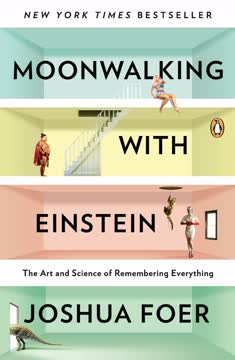重点摘要
1. 记忆是一个过程,而不是一个物体:理解其阶段可以增强学习
记忆并不存在于某种可以看到、触摸、称重或X光检查的物体(如器官、腺体等)中。
记忆作为一个过程。 记忆不是一个有形的结构,而是一个涉及多个系统和阶段的抽象过程。主要有三个阶段:
- 获取/编码:学习材料
- 存储:保留信息
- 提取:回忆存储的信息
理解这些阶段有助于开发有效的学习策略。例如,在获取阶段专注于编码技术,使用复述来存储,并练习提取方法,可以显著提高整体记忆表现。
短期记忆与长期记忆。 这两个系统在容量、持续时间和功能上有所不同:
- 短期记忆:容量有限(约7个项目),遗忘速度快
- 长期记忆:几乎无限的容量,相对永久的存储
认识到这些差异可以针对不同类型的信息和学习目标采取量身定制的方法。
2. 记忆术:提高记忆和回忆的强大技巧
记忆术并不是为了推理、理解和解决问题等任务而设计的;它们的目的是帮助学习和记忆。
记忆术技巧。 记忆术是人为的记忆辅助工具,通过赋予无意义的材料以意义或结构来帮助记忆。它们包括:
- 首字母缩略词和首字母诗(例如,ROY G. BIV代表彩虹的颜色)
- 视觉图像联想
- 押韵和模式
- 抽象概念的替代词
记忆术系统。 更复杂的记忆术系统可以用于大量信息:
- 链接系统:将项目按链条关联
- 地点系统:将项目放置在想象中的位置
- 挂钩系统:将项目与预先记住的“挂钩”关联
- 语音系统:将数字转换为易记的词语
这些系统特别适用于记住列表、数字和有序信息。虽然它们需要初步学习的努力,但可以显著提高各种任务的记忆表现。
3. 注意力和意义:有效记忆的关键因素
如果你想记住某件事,你必须注意它,集中精力,并确保你首先获得它。
注意力。 许多“遗忘”的实例实际上是由于缺乏注意力而未能正确编码信息。为了提高记忆:
- 积极关注你想记住的信息
- 在学习期间尽量减少干扰
- 使用自我对话技术来加强注意力(例如,“我把钥匙放在桌子上”)
意义。 有意义的信息更容易记住。增加意义的策略包括:
- 将新信息与现有知识联系起来
- 创建具体的例子或类比
- 将抽象概念分解为更具体的组成部分
- 使用模式或规则来组织信息
通过将集中注意力与使信息更有意义的努力结合起来,你可以显著增强记忆和回忆信息的能力。
4. 组织和联想:更好记忆保持的关键策略
材料在长期记忆中也被组织起来,这样你就不需要在记忆中搜索所有内容来找到特定信息。
组织。 组织信息有助于存储和提取:
- 将相关项目分组
- 创建层次结构或类别
- 使用大纲或思维导图
- 应用序列位置效应(更好地记住第一个和最后一个项目)
联想。 将新信息与现有知识联系起来可以增强记忆:
- 在新旧事实之间创建心理联系
- 使用类比或隐喻
- 将信息与个人经验联系起来
- 应用“围绕它思考”技术进行回忆
通过组织信息和创建联想,你可以创建多个提取路径,使在需要时更容易访问存储的信息。这种方法对于复杂或大量信息特别有效。
5. 视觉图像:增强记忆表现的有力工具
视觉图像可以提高对语言材料的记忆。
图像的力量。 视觉图像是一种非常有效的记忆辅助工具,因为:
- 图像比单独的词语更容易记住
- 具体的图像可以代表抽象的想法
- 双重编码(语言和视觉)增加了回忆的机会
有效的视觉联想。 为了最大化视觉图像的好处:
- 创建生动、详细的心理图像
- 使用图像中元素之间的互动
- 融入运动或夸张
- 使图像具有个人意义
视觉图像可以应用于各种学习任务,从词汇获取到记住复杂概念。它在记忆术系统如地点法或挂钩系统中特别有用,其中项目与生动的心理图像相关联。
6. 过度学习和间隔重复:长期保持的技巧
过度学习,即在掌握或仅仅回忆的基础上继续学习,已被证明在加强学习和提高提取速度方面有效。
过度学习。 在初步掌握后继续学习材料:
- 加强记忆痕迹
- 提高长期保持
- 增加提取速度和信心
间隔重复。 将学习课程分散在时间上:
- 比集中练习(突击学习)更有效
- 允许在课程之间进行记忆巩固
- 减少不同信息集之间的干扰
将过度学习与间隔重复结合起来可以显著提高长期保持。例如,在初步学习后以逐渐增加的间隔(1天、1周、1个月)复习材料,可以显著提高长期回忆。
7. 环境和兴趣:影响记忆的环境因素
对位置的视觉形式的了解可以帮助我们记住相关的信息。
环境效应。 学习发生的环境会影响回忆:
- 物理环境:房间、位置、背景噪音
- 心理环境:情绪、心理状态
- 材料环境:周围信息或呈现格式
利用环境效应:
- 在类似于回忆发生的环境中学习
- 变换学习环境以减少环境依赖
- 在回忆时心理重现学习环境
兴趣。 个人兴趣显著影响记忆:
- 增加注意力和动机
- 导致对信息的更深入处理
- 增强与现有知识的联系
为了提高对不太感兴趣材料的记忆,尝试:
- 找到个人相关性或应用
- 通过提出问题来激发好奇心
- 将信息与感兴趣的话题联系起来
通过考虑环境和兴趣,你可以为学习和回忆创造更有利的条件。
8. 有效的学习策略:SQ3R方法和其他学习技巧
有效的学习方法应:基于有效学习的策略,帮助你识别和理解材料的重要部分,帮助你记住材料的重要部分,比单纯反复阅读材料更高效,易于学习。
SQ3R方法。 一种广泛使用的学习系统:
- 浏览:了解材料的概况
- 提问:对内容提出问题
- 阅读:积极阅读以回答问题
- 复述:用自己的话总结要点
- 复习:定期回顾和加强学习
其他有效的学习策略:
- 积极回忆:定期自我测试
- 精细复述:用自己的话解释概念
- 记笔记:组织和总结信息
- 教别人:加强理解和记忆
这些策略促进了对材料的积极参与,比被动阅读或死记硬背更有助于理解和保持。
9. 记忆术在教育中的应用:增强各学科的学习
记忆术帮助学生更快地记住更多信息,并且保持更长时间。
在教育中的应用。 记忆术可以有效地用于各个学科:
- 历史:记住日期、事件和顺序
- 科学:学习分类法、公式和过程
- 语言:词汇获取和语法规则
- 数学:记住公式和程序
记忆术在学习中的好处:
- 更快地初步获取信息
- 改善长期保持
- 增加学生的参与和动机
- 适用于不同的学习风格
虽然记忆术特别适用于事实回忆,但它们也可以通过提供组织复杂信息的框架来作为更深入理解的基础。
10. 记住名字和面孔:社交互动的实用技巧
高度自我意识的人比不特别自我意识的人更难记住名字。
名字-面孔记忆系统。 一个五步法:
- 获取名字:确保你听到并正确理解
- 使名字有意义:创建联想或使用替代词
- 专注于面孔:注意独特特征
- 将名字与面孔关联:创建生动、难忘的链接
- 复习关联:心理复习连接
其他策略:
- 在对话中使用对方的名字
- 尽可能写下名字
- 定期练习回忆名字和面孔
提高名字-面孔记忆不仅增强社交互动,还展示了对他人的真诚兴趣,促进个人和职业关系的改善。
11. 克服心不在焉:前瞻性和回顾性记忆的策略
心不在焉是我们能够以较少的有意识注意力进行许多复杂活动所付出的代价。
前瞻性记忆。 记住未来要执行的动作:
- 使用外部辅助工具:日历、提醒、闹钟
- 创建视觉提示:将物品放在显眼位置
- 发展例行程序:将任务纳入日常习惯
- 使用实施意图:“当X发生时,我将做Y”
回顾性记忆。 记住过去的动作或信息:
- 在原始事件期间注意
- 在执行动作时创建生动的心理图像
- 使用“围绕它思考”技术重构事件
- 为常丢失的物品建立一致的位置
通过实施这些策略,你可以显著减少遗忘的实例,并提高记住未来任务和回忆过去动作或信息的能力。
最后更新日期:
FAQ
What's Your Memory: How It Works and How to Improve It about?
- Focus on Memory Improvement: The book explores the nature of memory, how it works, and practical techniques to enhance it. It combines scientific research with practical advice, making it accessible to a wide audience.
- Debunking Myths: Kenneth L. Higbee addresses common myths about memory, such as the belief that some people are simply born with good or bad memories. He emphasizes that memory can be improved through techniques and practice.
- Practical Techniques: The book provides various mnemonic systems and strategies, such as visualization and association, to help readers remember information more effectively.
Why should I read Your Memory: How It Works and How to Improve It?
- Enhance Memory Skills: The book offers practical methods to enhance your memory, which can be beneficial in both personal and professional contexts. Readers can expect to learn techniques that can be applied immediately.
- Research-Based Insights: Higbee combines his academic background in psychology with real-world applications, providing a balanced perspective on memory improvement. This makes the book credible and informative.
- Versatile Applications: The strategies can be applied to a wide range of situations, from studying for exams to remembering names at social gatherings, making it a versatile resource.
What are the key takeaways of Your Memory: How It Works and How to Improve It?
- Memory is a Process: The book emphasizes that memory is not a tangible thing but rather a complex process involving acquisition, storage, and retrieval. Understanding this can help readers manage their expectations about memory.
- Mnemonic Systems: The book introduces several mnemonic systems, including the Link, Loci, Peg, and Phonetic methods, each with unique applications for memory enhancement.
- Importance of Attention: A recurring theme is the significance of attention in memory retention; without focused attention, memory lapses are more likely to occur.
What are some effective memory techniques mentioned in Your Memory: How It Works and How to Improve It?
- Visualization: Creating vivid mental images to associate with the information you want to remember can significantly enhance recall. For example, picturing a dog sweeping with a broom can help you remember the words "dog" and "broom."
- Chunking: This technique involves grouping information into larger, manageable units to improve memory capacity. For instance, remembering a long number as smaller chunks (e.g., 376-315-374-264) makes it easier to recall.
- Association: Relating new information to something you already know can help solidify memories. For example, associating the Spanish word "pato" (duck) with the keyword "pot" can create a memorable image.
What is the Loci mnemonic system in Your Memory: How It Works and How to Improve It?
- Memory Palace Concept: The Loci system involves visualizing a familiar place (like your home) and associating items you want to remember with specific locations within that place. This method leverages spatial memory to enhance recall.
- Historical Use: This technique dates back to ancient Greece and was used by orators to remember long speeches. It is effective because it combines visualization with spatial organization.
- Practical Application: To use the Loci system, mentally walk through your chosen location and place the items you want to remember at specific points. When you need to recall the information, simply retrace your steps in your mind.
How does the Peg System function in Your Memory: How It Works and How to Improve It?
- Concrete Associations: The Peg System uses a list of pre-memorized words (pegs) that correspond to numbers, allowing you to associate new information with these pegs. This makes it easier to remember ordered information.
- Example of Application: For instance, if you want to remember a list of items, you might associate the first item with "bun" (1), the second with "shoe" (2), and so on. This creates a structured way to recall the items based on their numerical order.
- Direct Retrieval: The Peg System allows for direct retrieval of items by simply recalling the peg associated with a number, making it efficient for remembering lists and sequences.
What is the Phonetic System in Your Memory: How It Works and How to Improve It?
- Consonant Sounds for Digits: The Phonetic System assigns specific consonant sounds to each digit (0-9), allowing you to create words that represent numbers. This makes numbers more memorable by turning them into meaningful words.
- Example of Use: For example, the number 23 could be represented by the word "Noah," where "n" corresponds to 2 and "h" corresponds to 3. This transforms abstract numbers into concrete, memorable words.
- Versatile Applications: The Phonetic System can be used for various applications, including remembering phone numbers, dates, and other numerical information, making it a powerful tool for enhancing memory.
How does Your Memory: How It Works and How to Improve It address the issue of forgetting?
- Understanding Forgetting: Higbee explains that forgetting is often a result of failure at one of the three stages of memory: acquisition, storage, or retrieval. This understanding can help readers identify where they may be struggling.
- Five Explanations for Forgetting: The book discusses various theories, including decay, repression, distortion, interference, and cue dependency, to explain why we forget. Each explanation provides insight into different aspects of memory failure.
- Practical Strategies: To combat forgetting, the book suggests techniques such as spaced repetition and overlearning, which can help reinforce memory retention over time.
What is the importance of attention in memory according to Your Memory: How It Works and How to Improve It?
- Critical for Learning: Attention is essential for encoding information into memory. As Higbee states, “A man must get a thing before he can forget it,” highlighting that without attention, information may never be properly learned.
- Impact of Distractions: Divided attention can hinder memory performance, as people often fail to fully engage with the material they are trying to learn. This is particularly relevant in today’s distraction-filled environments.
- Strategies to Enhance Attention: The book suggests techniques such as minimizing distractions and actively engaging with the material to improve focus and retention.
How can I use the principles of meaningfulness and organization to improve my memory as suggested in Your Memory: How It Works and How to Improve It?
- Make Material Meaningful: The more meaningful the information is to you, the easier it will be to remember. For example, relating new concepts to personal experiences can enhance understanding and recall.
- Organize Information: Structuring information logically, such as using outlines or categories, can help facilitate memory retrieval. Organized material is easier to navigate in your mind, similar to how a well-organized file cabinet works.
- Use Familiarity and Patterns: Familiarity with the subject matter can aid memory, as can recognizing patterns within the information. For instance, grouping related items together can create a mental framework that enhances recall.
What are some common memory myths discussed in Your Memory: How It Works and How to Improve It?
- Memory is a Thing: Many people mistakenly believe that memory is a tangible object rather than a process. This myth can lead to unrealistic expectations about memory improvement.
- Photographic Memory: The idea that some individuals possess a photographic memory is largely a myth; most exceptional memory feats can be attributed to learned techniques rather than innate abilities.
- Age and Memory: The belief that older adults cannot improve their memory is also a myth. The book emphasizes that memory skills can be developed at any age with practice and the right techniques.
How does Your Memory: How It Works and How to Improve It suggest overcoming anxiety related to memory tasks?
- Relaxation Techniques: Higbee recommends using relaxation methods, such as meditation, to calm the mind and body before memory tasks. Reducing anxiety can enhance focus and improve recall.
- Preparation and Overlearning: Being well-prepared for tests or presentations can significantly reduce anxiety. Overlearning material helps build confidence, making it easier to recall under pressure.
- Practice and Feedback: Engaging in practice tests and receiving feedback can help alleviate anxiety by providing a clearer understanding of what you know and what you need to work on. This approach fosters a sense of control over the material.
评论
《你的记忆:它如何运作以及如何改善》因其对记忆技巧的学术性方法而备受推崇。读者称赞其对助记法的全面覆盖,并有科学研究作为支持。许多人希望在他们的教育早期就能发现这本书。书中解释了各种记忆系统,包括联想法、地点法和语音法。尽管有些人觉得内容密集或重复,但大多数人都欣赏其实际应用。评论者指出,在应用这些技巧后,他们记住信息的能力显著提高,尽管为了获得长期效果,需要持续练习。
Similar Books














